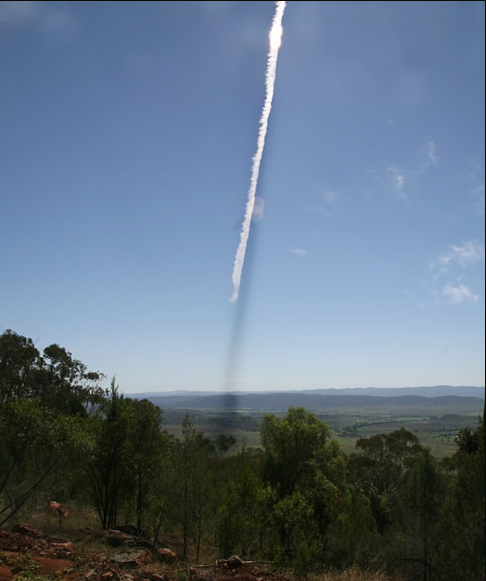3D Contrail Shadow
3D Contrail Shadow: A Phenomenon in the Skies
Contrails, the visible trails of condensed water vapor left behind by aircraft, sometimes exhibit an intriguing phenomenon known as a 3D contrail shadow. While contrails themselves are a common sight in the sky, the addition of a dark line or shadow creates a captivating visual effect. This shadow is cast onto a lower layer of very thin cirrus cloud or atmospheric haze, and it can extend deep into the hazy atmosphere, forming a three-dimensional volume of unlit air that reaches all the way down to the ground.
The Fascinating Nature of Contrail Shadows
Contrail shadows offer a unique perspective on the interaction between sunlight, contrails, and atmospheric conditions. Not only can these shadows be cast onto the lower cloud layer or haze, but they can also extend to the surrounding landscape. In some cases, distant hills may appear darker due to the intervening shadowed air, which prevents the predominantly blue sunlight from scattering.
Exploring the Mechanics of Contrail Shadows
To understand how contrail shadows form, we must delve into the underlying mechanics at play. When an aircraft passes through the atmosphere, it emits exhaust gases containing water vapor and other byproducts. As these hot gases mix with the colder air, they quickly cool and condense into tiny ice crystals. These ice crystals then form the visible contrail.
When sunlight interacts with these ice crystals, it scatters in different directions, creating the characteristic white appearance of contrails. However, if there is a thin layer of cirrus clouds or atmospheric haze beneath the contrail, a shadow can be cast onto this lower layer. The shadow appears as a dark line due to the absence of scattered sunlight in that region.
Factors Influencing Contrail Shadow Formation
The formation of a 3D contrail shadow is dependent on various factors, including atmospheric conditions and the position of the sun relative to the contrail. Some key factors influencing the appearance and extent of contrail shadows include:
- Thickness and opacity of the cirrus clouds or atmospheric haze
- Altitude and shape of the contrail
- Angle of the sun relative to the contrail and the observer's position
These factors interact in complex ways, resulting in a range of contrail shadow phenomena, from subtle lines to more pronounced and expansive shadows.
Observing and Capturing Contrail Shadows
Spotting a 3D contrail shadow requires a combination of favorable conditions and keen observation. To increase your chances of witnessing this phenomenon, keep the following tips in mind:
- Look for contrails passing through thin cirrus clouds or atmospheric haze.
- Pay attention to the position of the sun, as contrail shadows are most visible when the sun is low on the horizon.
- Choose a vantage point that allows you to see both the contrail and its potential shadow.
For photography enthusiasts, capturing a 3D contrail shadow can result in stunning images. Experiment with different angles, compositions, and lighting conditions to bring out the full beauty of this atmospheric optical phenomenon.
The Awe-Inspiring World of Atmospheric Optics
The study of atmospheric optics encompasses a wide range of captivating phenomena, including contrail shadows. From rainbows and halos to mirages and iridescence, our atmosphere is teeming with visual wonders waiting to be discovered. Exploring these phenomena not only deepens our understanding of the natural world but also provides a sense of awe and appreciation for the intricate interplay between light, air, and particles.
As we continue to unravel the mysteries of atmospheric optics, we gain valuable insights into the dynamics of our atmosphere and its impact on our daily lives. Whether it's the enchanting beauty of a 3D contrail shadow or the ethereal glow of a halo, these phenomena serve as reminders of the remarkable complexity and beauty that surround us in the skies above.

Contrail Shadow by Ágúst Guðmundsson. Imaged during the 10th Paragliding World Championship 500 km north of Sydney, Australia March 4,'07. ©�g�st Gu�mundsson, shown with permission.
Aircraft contrails are occasionally seen paired with a dark line, their shadow cast onto on a lower layer of very thin cirrus cloud or atmospheric haze.
Here the shadow is cast deep through the hazy atmosphere. The shadow is a 3D volume of unlit air that extends down to ground level.
The shadow might also be cast onto the landscape. Alternatively, the distant hills could appear darker because the intervening shadowed air cannot scatter (predominantly blue) sunlight.
Note: this article has been automatically converted from the old site and may not appear as intended. You can find the original article here.
Reference Atmospheric Optics
If you use any of the definitions, information, or data presented on Atmospheric Optics, please copy the link or reference below to properly credit us as the reference source. Thank you!
-
<a href="https://atoptics.co.uk/blog/3d-contrail-shadow/">3D Contrail Shadow</a>
-
"3D Contrail Shadow". Atmospheric Optics. Accessed on December 22, 2024. https://atoptics.co.uk/blog/3d-contrail-shadow/.
-
"3D Contrail Shadow". Atmospheric Optics, https://atoptics.co.uk/blog/3d-contrail-shadow/. Accessed 22 December, 2024
-
3D Contrail Shadow. Atmospheric Optics. Retrieved from https://atoptics.co.uk/blog/3d-contrail-shadow/.